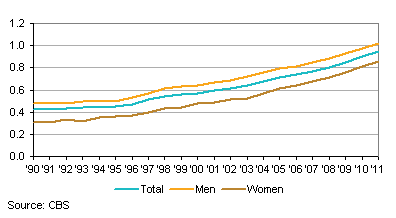Employed labour force is ageing

The average age in the employed labour force has risen further in 2011 to just over 41 versus 36 in the early 1990s. Men in their fifties for the first time outnumbered men in their thirties. The ageing process was most obvious in the sector public administration and government services.
Average age employed labour force 41.2 years
The average age in the employed labour force has risen by 5 years to 41.2 between 1990 and 2011. The population has aged during this period. The labour participation rate among 50 to 65-year-olds also increased noticeably, i.e. from 35 percent in 1990 to 60 percent in 2011. The increase was mainly recorded among women.
Average age employed labour force and net labour participation rate in the 50 to 65-year-old population

More working men between 50 and 60 than between 30 and 40
Last year, there were 95 employed in the 50–60 age bracket in every 100 employed in the 30–40 age bracket versus only 42 in the early 1990s. In those days, relatively few 50 to 60-year-old women were engaged in paid employment and the labour participation rate among men in the same age category was rather low, partly due to the then generous early retirement schemes. In 2011, employed men between 50 and 60 for the first time outnumbered those between 30 and 40.
People in their fifties versus people in their thirties in the employed labour force

Ageing process most noticeable in the sector public administration and government services
In the period 1990–2010, the average age increased in all sectors. With 7 years, the increase was most substantial in public administration and government services, followed by health care and welfare, manufacturing industry and financial institutions with met 6 years.
The highest average age in 2010 was recorded in the sector agriculture and fishing (44 years), followed by education and public administration and government services with 43 years. The average age was lowest in the sector hotels and restaurants (more than 34 years).
Average age employed labour force by sector

Koos Arts and Ferdy Otten